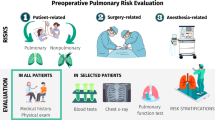Abstract
We aimed to clarify the long-term outcomes and prognosis of vocal cord paralysis (VCP) after cardiothoracic surgery in infants as well as the usefulness of laryngeal ultrasound (LUS) as screening for VCP. Overall, 967 infants aged 1-year-old or younger who underwent cardiothoracic surgery between 2008 and 2022 were included in this study. We divided the patients into two groups based on the period on whether they underwent screening without or with LUS and compared the incidence of VCP between the groups. There were no differences in the patients’ preoperative characteristics between the two periods, whereas the incidence of VCP was significantly higher in period 2 than in period 1 (11.0% vs. 3.2%, p < 0.0001). The incidence of VCP among the procedures, including aortic arch repair, was > 50% and significantly increased from period 1 to period 2. The sensitivity and specificity of LUS was 87% and 90%, respectively. Symptoms of VCP improved in 92% of patients. Repeated flexible laryngoscopy revealed that the residual rate of VCP was 68%, 52%, and 48% at 6, 12, and 24 months, respectively. In conclusion, symptoms of postoperative VCP improved in most cases; however, paralysis persisted in half of the patients. As a screening method, LUS is useful for evaluating postoperative VCP. A more accurate understanding of VCP is needed to improve postoperative outcomes.





Similar content being viewed by others
References
Sachdeva R, Hussain E, Moss MM et al (2007) Vocal cord dysfunction and feeding difficulties after pediatric cardiovascular surgery. J Pediatr 151(3):e312–e315
Lee MGY, Millar J, Rose E et al (2018) Laryngeal ultrasound detects a high incidence of vocal cord paresis after aortic arch repair in neonates and young children. J Thorac Cardiovasc Surg 155(6):2579–2587
Pourmoghadam KK, DeCampli WM, Ruzmetov M et al (2017) Recurrent laryngeal nerve injury and swallowing dysfunction in neonatal aortic arch repair. Ann Thorac Surg 104(5):1611–1618
Ambrose SE, Ongkasuwan J, Dedhia K et al (2018) Analysis of vocal fold motion impairment in neonates undergoing congenital heart surgery. JAMA Otolaryngol–Head Neck Surg 144(5):406–412
García-Torres E, Antón-Pacheco JL, Luna-Paredes MC et al (2020) Vocal cord paralysis after cardiovascular surgery in children: Incidence, risk factors and diagnostic options. Eur J Cardiothorac Surg 57(2):359–365
Carpes LF, Kozak FK, Leblanc JG et al (2011) Assessment of vocal fold mobility before and after cardiothoracic surgery in children. Arch Otolaryngol Head Neck Surg 137(6):571–575
Ongkasuwan J, Ocampo E, Tran B (2017) Laryngeal ultrasound and vocal fold movement in the pediatric cardiovascular intensive care unit. Laryngoscope 127(1):167–172
Sanchez-Jacob R, Cielma TK, Mudd PA (2022) Ultrasound of the vocal cords in infants. Pediatr Radiol 52(9):1619–1626
Averin K, Uzark K, Beekman RH 3rd, Willging JP, Pratt J, Manning PB (2012) Postoperative assessment of laryngopharyngeal dysfunction in neonates after norwood operation. Ann Thorac Surg 94(4):1257–1261
Wong KP, Lang BH, Ng SH, Cheung CY, Chan CT, Lo CY (2013) A prospective, assessor-blind evaluation of surgeon-performed transcutaneous laryngeal ultrasonography in vocal cord examination before and after thyroidectomy. Surgery 154(6):1158–1164
Wong KP, Lang BH, Chang YK, Wong KC, Chow FC (2015) Assessing the validity of transcutaneous laryngeal ultrasonography (tlusg) after thyroidectomy: What factors matter? Ann Surg Oncol 22(6):1774–1780
Amis RJ, Gupta D, Dowdall JR, Srirajakalindini A, Folbe A (2012) Ultrasound assessment of vocal fold paresis: a correlation case series with flexible fiberoptic laryngoscopy and adding the third dimension (3-d) to vocal fold mobility assessment. Middle East J Anaesthesiol 21(4):493–498
Sidhu S, Stanton R, Shahidi S, Chu J, Chew S, Campbell P (2001) Initial experience of vocal cord evaluation using grey-scale, real-time, b-mode ultrasound. ANZ J Surg 71(12):737–739
Wong KP, Lang BH, Lam S, Au KP, Chan DT, Kotewall NC (2016) Determining the learning curve of transcutaneous laryngeal ultrasound in vocal cord assessment by cusum analysis of eight surgical residents: When to abandon laryngoscopy. World J Surg 40(3):659–664
Kenny L, McIntosh A, Jardine K et al (2022) Vocal cord dysfunction after pediatric cardiac surgery: A prospective implementation study. JTCVS open 11:398–411
Jabbour J, Martin T, Beste D, Robey T (2014) Pediatric vocal fold immobility: Natural history and the need for long-term follow-up. JAMA Otolaryngol Head Neck Surg 140(5):428–433
Mery CM, Guzmán-Pruneda FA, Carberry KE et al (2014) Aortic arch advancement for aortic coarctation and hypoplastic aortic arch in neonates and infants. Ann Thorac Surg 98(2):625–633
Mau T, Pan HM, Childs LF (2017) The natural history of recoverable vocal fold paralysis: Implications for kinetics of reinnervation. Laryngoscope 127(11):2585–2590
Irace AL, Dombrowski ND, Kawai K et al (2019) Aspiration in children with unilateral vocal fold paralysis. Laryngoscope 129(3):569–573
Acknowledgements
None.
Funding
None.
Author information
Authors and Affiliations
Contributions
NM drafted and edited the manuscript; TO, MK, KS and TO contributed to data collection and refinement. NM contributed to data refinement and led the statistical analysis. TK, MK, AO and HT significantly edited the manuscript and oversaw the study from design to completion. SS significantly edited the manuscript and supervised the work and submission. All authors agree to be accountable for the content of the work.
Corresponding author
Ethics declarations
Conflict of interest
The authors have no conflicts of interest to disclose.
Additional information
Publisher's Note
Springer Nature remains neutral with regard to jurisdictional claims in published maps and institutional affiliations.
Supplementary Information
Below is the link to the electronic supplementary material.
Rights and permissions
Springer Nature or its licensor (e.g. a society or other partner) holds exclusive rights to this article under a publishing agreement with the author(s) or other rightsholder(s); author self-archiving of the accepted manuscript version of this article is solely governed by the terms of such publishing agreement and applicable law.
About this article
Cite this article
Masaki, N., Tatewaki, H., Kumae, M. et al. Clinical Prognosis of Vocal Cord Paralysis After Cardiothoracic Surgery in Infants. Pediatr Cardiol 45, 40–47 (2024). https://doi.org/10.1007/s00246-023-03341-4
Received:
Accepted:
Published:
Issue Date:
DOI: https://doi.org/10.1007/s00246-023-03341-4




